Re-Membering the 1870s Migration
[Editor’s note: This is adapted from a presentation that John Thiesen gave April 13, 2025, at Bethel College’s Kauffman Museum in North Newton, Kan. It was part of a series of events that accompanied the museum’s special exhibit “Unlocking the Past: Immigrant Artifacts and the Stories They Tell” (Sept. 29, 2024-June 1, 2025), which looked at broader issues of immigration to North America, and Kansas in particular, through a lens of Mennonite migration from Imperial Russia in 1874.]
Daut wia soo lang tridj, daut es meist nijch meea soo.[1]
I originally wrote this talk for the annual Mennonite history conference in Winnipeg in October 2024, which focused on the 1870s immigration [of Mennonites to North America]. I understood my assignment to be to provide some contrast, a perspective from the United States or even specifically from Kansas, where the majority of the 1870s immigrants ended up. Some traces of that context are still in this talk.
In Canada, people have a mental model of three immigration episodes – the 1870s, 1920s, and 1940s, with various personality or cultural stereotypes associated with each of those episodes. And in Canada, they’ve been focusing in the last couple of years on the centennial of the 1920s migration. In the U.S. setting, the 1870s immigration episode is the only one (with a few exceptions) and those cultural stereotypes are also not present. I have family ties to all three of those episodes, which is highly unusual in my Kansas setting. My father’s grandparents came to Kansas in the 1870s. My mother and her family came to Chicago in 1926 (for which we can soon celebrate the centennial). And my maternal grandfather was an immigrant of both 1926 and 1947, but to the United States both times, not to Canada. I probably find the 1920s immigration closest to my personal memory and identity. But there were very few of those kinds of 1920s and 1940s people around me growing up, except on visits to or from the southern Manitoba and British Columbia relatives. So perhaps my understanding of the 1870s immigration is distorted by living among its descendants but holding it somewhat at arms’ length.
I have been thinking for a long time about a contrast I see between the way the 1870s immigration is spoken about among its U.S. inheritors and what one actually finds when looking at the archival sources for that episode. This of course assumes that there is in fact any kind of popular account about the immigration. In 2022 or 2023, it seemed like the 150th anniversary might go by with little attention. It seemed to me that the 1870s has largely been forgotten. But a number of commemorative events did happen. The Swiss Volhynians [in the Moundridge, Kan., area] had their program and the Goessel [Kan.] community did, and a few individual congregations. And there was the Kauffman Museum exhibit, “Unlocking the Past.” The history conference prompted me to try to organize my thinking into a more coherent presentation.
I’m not wanting to do any kind of sophisticated theoretical analysis of this. I haven’t, for example, tried to conduct a survey to find out what basic understandings there might be among the broader U.S. Mennonite public about the 1870s, although that could be an interesting project. The commemorative events that have taken place have probably put more of the 1870s stories into people’s minds than one might have found in, say, early 2022. And there is a vast academic literature about memory studies and commemoration that is just too huge and complicated to engage in this limited time. I’m basing my account of “popular stereotypes” on many years of conversations with users of the archives and other Mennonite-connected persons interested at least vaguely in Mennonite history.
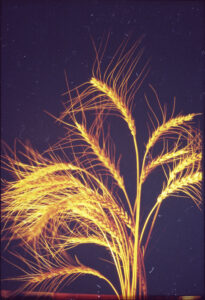
So let’s begin with wheat. That is the central element of the 1870s immigration story as U.S. Mennonites tell it. The nearly universal popular understanding is that Mennonite immigrants of 1874 brought “Turkey Red” hard winter wheat with them from Ukraine, thus turning Kansas into the breadbasket of the world. This understanding continues to be put forward today in newspaper articles and social media posts commenting on the 150th anniversary of the immigration. Some accounts will add another level of detail, reporting that the immigrants brought carefully selected small supplies of seed wheat with them which when planted exploded into the Kansas wheat landscape. A few will remember the romanticized story of little Anna Barkman counting out the best wheat kernels one by one for her family to bring along. But this popular understanding contains only a kernel of truth, like it or not.
The British historian David Moon has made my work easier by covering the Mennonite wheat story in some detail in his 2020 book The American Steppes: The Unexpected Russian Roots of Great Plains Agriculture, 1870s-1930s.[2] Moon asks most of the questions I would have asked about this story. I don’t agree with all of the details of his conclusions, and I think he overlooks certain aspects of the story (particularly German-language sources), or perhaps did not consider them relevant to his purposes. Most of what I have to say here follows or expands on Moon’s lead.
I have not found any contemporary 1870s evidence that the immigrants brought seed wheat with them. All the claims to that effect come a generation and more later. There are a number of journalistic accounts of Mennonite immigrants from the 1870s and 1880s, and while many of them mention Mennonites growing wheat, none of them mention Mennonites having brought seed wheat with them.[3] Perhaps the most well-known of these sources is a pamphlet by C.B. Schmidt, the Santa Fe Railroad immigration agent, describing the new Mennonite settlements in 1877 and 1878. Schmidt says nothing about imported seed wheat, although he describes other imported tools and equipment, but claims that Mennonites were growing 857,000 acres of winter wheat in 1877 and 1,243,000 acres in 1878. Moon passes over this figure uncritically, but this was actually the amount of winter wheat acreage of all varieties for the entire state of Kansas, grown by everyone, not just Mennonites – mostly not by Mennonites.[4]
At the same time, however, connections were made between Mennonites and wheat at the time of immigration. In U.S. Senate debates in early 1874 about a bill to offer incentives to Russian Mennonite immigrants, Sen. William Windom of Minnesota said, “They prefer our country, and unless we choose to drive away forty thousand of the very best farmers of Russia who are now competing with us in the markets of the world with some ten million bushels of their wheat, if we choose that Russia shall raise that wheat or that Canada shall provide it instead of our own country, we can simply reject the proffer of these people, and they probably will not become our citizens.”[5]
The earliest hint that David Moon found for the story of Mennonites bringing wheat was a letter in 1900 – a generation later – from Bernhard Warkentin, a Russian Mennonite entrepreneur who came to the United States already in 1872 and actively assisted the following migration as well as establishing a large milling business, to Mark Carleton, a U.S. Department of Agriculture scientist who actively collaborated with Warkentin in promoting seed wheat importation from Russia. Carleton had recently been to Russia investigating wheat varieties and importing some seed wheat. The Nov. 9, 1900, letter discussed this work with wheat varieties and related matters and asked for Carleton’s advice about which specific local geographic region from which to import a proposed 10-20,000 bushels of seed in time for the fall 1901 planting in Kansas. Warkentin said, “It has always been my idea that if it could be found in the Crimea from where it originally was brought here to Kansas by the Mennonites which settled in 1873 in Marion County, that it would be preferable,” implying rather vaguely both that the Gnadenau Mennonite group had brought some wheat with them but that not enough of it was grown to provide farmers with a good supply of seed even 25 years later.[6] Many years later, in 1914, Carleton elaborated in an article in the USDA Yearbook, without citing any sources, “Each family brought over a bushel or more of Crimean wheat for seed, and from this seed was grown the first crop of Kansas hard winter wheat.”[7] But this would seem to contradict Carleton’s own personal experience, since he had collaborated with Warkentin since the 1880s in importing large quantities of seed wheat and also well knew that varieties of hard winter wheat had been grown in Kansas before 1873. Carleton also notes in the same article, in the next sentence, “Bernard Warkentin, a miller, who erected mills at Newton and Halstead, was chiefly instrumental in introducing the Turkey wheat.”
It seems that the story really began building in the 1920s, 50 years after the immigration. Surprisingly, the impetus does not seem to have come from the 50th anniversary of the immigration itself. C. Henry Smith’s book The Coming of the Russian Mennonites, which is still the only comprehensive account almost a century later, was published in 1927 shortly after Smith had been teaching history at Bethel College. It has only a brief reference to Mennonite “influence” in making Turkey Red wheat a leading variety.[8]
A publication of a 50th-anniversary commemoration in Hillsboro, Kan., in 1924 also makes only a brief mention of wheat in a talk by C.C. Wedel (probably Cornelius C. Wedel, 1871-1954, a pastor of the Alexanderwohl church). Wedel is talking about the year 1875 and says, “The hard ‘Turkey’ wheat, of which some was brought in small bags and which Mr. B. Warkentin later introduced in larger quantities, was not sown until a few years later.”[9]
The little Anna Barkman story, which became the folkloric center of the wheat theme, seems to have been publicized first in a book by Bliss Isely, a Wichita journalist, in 1927. Isely compiled a book of brief Kansas history vignettes for children, apparently at the request of Wichita school teachers and administrators. Some of the stories were adapted from articles Isely wrote for the Wichita Beacon, one of the city’s newspapers.[10] Isely recounted how 8-year-old Anna was assigned by her father to select, one by one, two gallons (about a quarter of a bushel) of Turkey Red wheat to take along to America, and was rewarded with a handful of hazelnuts.[11] The Barkman family came to the United States on the ship City of Brooklyn, arriving in New York on July 15, 1874, and settling in Gnadenau, near Hillsboro, Kan.[12]
Isely had a somewhat expanded version of this story in the Beacon on May 15, 1927, presumably in preparation for the book publication.[13] He recounts the Anna Barkman story and says she counted out exactly 259, 862 grains of wheat! (I couldn’t figure out anything particularly special about that integer. It’s obviously not a prime and doesn’t seem to fall in any other special categories of number theory.) This Beacon article seems to be the first appearance of the Anna Barkman story in print. Isely credits an Andreous (sic) Flamming (sic) of Hillsboro for telling the Anna Barkman story and lists of the names of 24 families. Although he never uses the name Gnadenau, he is clearly talking about very specifically about the Gnadenau settlement. Isely didn’t generate his material himself. He says, “The list of names as given here was obtained by Prof. D.H. Richert of the Bethel College faculty, and Herbert Schmidt, student editor of The Collegian, of Bethel College at Newton. These two men, assisted by some other Bethel students, set out in March to collect data regarding the Mennonite migration. They have traveled hundreds of miles thru the chief Mennonite districts of Kansas, calling on the patriarchs of the colony and on younger people who have vivid recollections of the days of the migration.”
Isely somewhat undermines the story by also reporting Bernhard Warkentin’s 1885 importation of a larger amount of seed wheat from Russia. There is a considerable amount of pure fabrication in Isely’s article. He claims the Mennonite migration had something to do with Chancellor Bismarck of the newlycestablished German Empire withdrawing German “protection” of the Mennonites in Russia. The article includes an illustration with two threshing stones and several elderly Gnadenau people including Anna Barkman Wohlgemuth and Andreas Flaming.
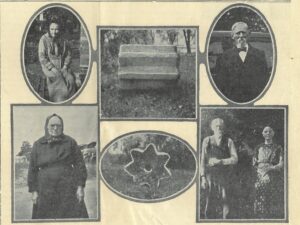
Collection of photos from a 1927 issue of The Bethel Collegian: Anna Barkman (Wolgemuth) on the left; Andreas Flaming and his wife, Katharina Wiens Flaming
A related article appeared in The Bethel Collegian, the student newspaper, dated May 25, 1927, just a few days after the Beacon article. The front-page article states, “Upon the request of the Beacon and the Wichita board of education made to Bethel College a story of an historic event which has made Kansas famous the world over was gathered and a few facts of it will be given here. A detailed story will appear in the book printed next August by the Wichita board of education which will be read in Wichita schools.”[14] The article then briefly recounts the story of Anna Barkman picking out kernels of wheat in return for the measly hazelnut treat. The Collegian article also adds another story that Isely didn’t tell and that hasn’t become part of the folklore. “Andreous [sic] Flamming [sic] who is another one of the six pioneers still living, was a teacher and hence a leader of the group. He is the man who sowed the first hard winter wheat on American soil. He brought a peck [2 gallons, a quarter of a bushel, the same amount credited to Anna Barkman] of the grain with him and sowed it 1½ miles west of Florence [Kan.]. This peck produced 2½ bushels of perfect wheat.”[15] It’s surprising that this much more believable Flaming story has been forgotten. The Flaming family also came on the City of Brooklyn. The article credits “twenty-six families,” (Isely says 24) “that brought small quantities of wheat with them in their trunks.” The article includes the same photos as the Beacon article. Both Anna Barkman and Andreas Flaming died in 1929. Flaming’s obituary makes no mention of wheat in any way. I haven’t found an Anna Barkman Wohlgemuth obituary.
One additional clue about the origin of these stories is a Collegian article of March 23, 1927. Isely was “working out some information regarding the introduction of hard winter wheat by Mennonites from Russia” and had contacted David H. Richert to ask students for help. “Since most Bethel students are sons and daughters of the people that helped to bring in this wheat they ought to be well qualified to gather information concerning this bit of history.” The article offered a list of questions:
1. Who brought over the first wheat?
2. What was his name and the names of members of his family?
3. Did they carry it as hand baggage or did they check it?
4. How much did they carry?
5. If several persons brought over the wheat together, what were the names of all of them?
6. Interview the men and women who brought over the wheat, having them tell their own stories of their journey, length of time to make the voyage, kind of ship, how they travelled and such matters.
The article ended somewhat passively: “If anybody can and wants to help,” they should contact Richert or Herbert Schmidt.
This still leaves most questions unanswered. There is no trace of this request or responses to it in Richert’s papers or elsewhere in the college archives. There is also no trace of it in Isely’s own papers in the Wichita State University archives. It would seem that if Richert and students had “traveled hundreds of miles” in pursuit of this matter, they would have left more of a record. The March Collegian article has more of the tenor of just passing along stories that students might have to offer.
One would also wonder why Isely contacted Richert specifically. Richert was a professor of math and astronomy, not history or agriculture. There does not seem to be a clear reason why he would be the person at Bethel to respond to this kind of request. And what prompted Isely to take an interest in the wheat story, even though the theme connecting Mennonites and Turkey Red wheat wasn’t all that prominent yet?
It is striking that the 1924 pamphlet mentioned above of the Hillsboro 50th-anniversary celebration, right near Gnadenau, makes no mention of the Anna Barkman or Andreas Flaming stories. This was where the protagonists of the story were living at the time and adjacent to the original Gnadenau settlement. It seriously undermines the credibility of the story. The definitive history of Gnadenau also makes little of the wheat importation story. David V. Wiebe states, in a photo caption, “How many Mennonite immigrants brought seed wheat to America is not known,”[16] then quotes a couple of sentences of the Anna Barkman story from Isely’s book, implying Wiebe did not know the story from local community sources. A bit later, he reports on the first planting efforts to plant wheat and rye: “Some of the seed they had brought along from Crimea – carefully handpicked.”[17] Wiebe dismissed the wheat importation story with half a sentence, and even implies it might have been rye, not just wheat.
It is also striking that the only wheat seed importation stories that are tied to specific persons or families, rather than just the generic “Mennonite immigrants brought wheat with them,” are tied to Gnadenau. No one seems to have noticed before that there are no stories like this for other 1870s immigrant communities besides Gnadenau.
The association of Mennonites with wheat became entrenched fairly quickly after Isely, with occasional variations. An article in the Topeka Daily Capital, on Sunday, April 5, 1931, told the story with a focus on Andreas Flaming and no mention of Anna Barkman. The article included a photo of the Flamings (he had died in an auto accident in 1929, Mrs. Flaming was still living in 1931). There is no indication of the author of the article (it just says “Special to The Capital”) nor the impetus for printing it at this particular time.[18]
The Federal Writers’ Project, a New Deal program, picked up the story in a very generic way in their Kansas guide volume, noting “the bushel or so of hand-picked hard ‘Turkey Red’ wheat carefully stowed away in the baggage of each family.”[19] In July 1941, the Kansas Industrial Development Commission broadcast a radio play about wheat as part of a series of public education programs. The Anna Barkman story, presumably borrowed from Isely, was one of two vignettes in the program.
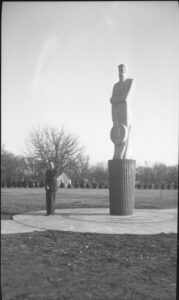
Walter Thiesen standing at Mennonite Settler statue in Athletic Park, Newton, Kan., January or February, 1943
Another New Deal manifestation came to Newton, Kan., in 1942, a “Mennonite settler” statue in the town’s main park. The origins of this are somewhat murky. It was a town business project rather than a Mennonite project. The Junior Chamber of Commerce, which included a number of businessmen of Mennonite background, was looking for a project and somehow came up with the idea of commemorating wheat in a public monument. This coincided with federal programs for employing artists and promoting public art, and so the Works Progress Administration, a New Deal agency, employed artist Max Nixon, who had never done sculpture before, to create the monument. Nixon came up with an austere, anonymous Mennonite settler, and apparently the design was not well received in the community. In the time from 1940-42 while the work was going on, the United States entered the World War II and it became awkward for the community to be commemorating a group that was known for being conscientious objectors to war. Reportedly, no Mennonites were invited to speak at the dedication ceremony. The text beneath the statue reads, “Commemorating Entry Into Kansas From Russia Of Turkey Red Wheat By Mennonites, 1874.”[20]
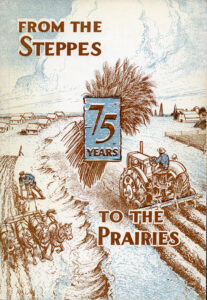
Book cover, From the Steppes to the Prairies by Cornelius Krahn
At the same time, there continued to be skepticism about Mennonite wheat. The 75th-anniversary book published in 1949 shows wheat images on the cover, but inside there is very little reference to the claim of Mennonites bringing seed wheat. Cornelius Krahn makes the only explicit mention of it, unfortunately without giving sources:
“In 1874 the Mennonites from Russia sowed their first wheat in this country. It was nothing extraordinary. Many people had sowed wheat in Kansas before. At this time T.C. Henry, of Salina, had thousands of acres of wheat… . The quantity of red Turkey seed-wheat brought along by the Mennonites must, according to all available evidence, having [sic] been small. It was, first of all, Warkentin who realized the great superiority of this variety of wheat in comparison to the soft varieties. He verified this by experiments on his farm, in his mill, and by the experiences of other farmers. To increase production of hard winter wheat he imported a large shipment of it from the Crimea in 1885-86 for distribution among the farmers.”[21]
Another chapter in the book, by P.A. Wiebe, talks about the high price of seed wheat when the Gnadenau group (the village of the Barkmans and Flaming) arrived, but makes no mention of bringing wheat along. Wiebe’s article was originally written in 1912 and included in this volume 37 years later.[22]
In 1974, in the midst of the centennial celebrations, Cornelius Krahn repeated his skepticism from 25 years earlier, here connecting to C. B. Schmidt’s early accounts. “By now the descendants of the winter wheat pioneers are tempted to count the kernels that their ancestors brought along and sowed in the prairie upon arrival. The success C.B. Schmidt had as an agent of the Santa Fe spurred him to exaggerate figures and facts. There should be no reasons for us at this time to do the same. First of all there does not seem to be any evidence at this time that Mennonites planted winter wheat in the fall upon their arrival in 1874. There are numerous evidences that they bought spring wheat in 1875 for their first seeding in the prairie. Some hard winter wheat came in only gradually and on a larger scale only after Bernhard Warkentin and Mark Carleton had imported large quantities of Red Turkey seed wheat from the Ukraine where the Mennonites had come from.”[23]
But the wheat story really took off in 1974 with the centennial observances. I would credit one specific person, Harley Stucky (1920-2005), with solidifying the wheat trope. Stucky was a Kansas Mennonite entrepreneur and college professor/administrator. His ancestry was in the Swiss Volhynian subgroup so his ancestors came from the Russian Empire in the 1870s but not from the regions or subgroups to which Turkey Red wheat has usually been traced.
The Kansas legislature passed a resolution proclaiming 1974 the Turkey Red hard winter wheat centennial. The text describes roles of Mennonites and of Warkentin but also says, “After arrival of the immigrating Mennonites, about 1885 or 1886, Warkentin imported the first large shipments of Turkey red hard winter wheat for expansion of the early hard winter wheat industry in Kansas,” somewhat undercutting the centennial idea. The resolution was introduced by Representative Walter W. Graber from Pretty Prairie, also a Swiss Volhynian Mennonite.[24]
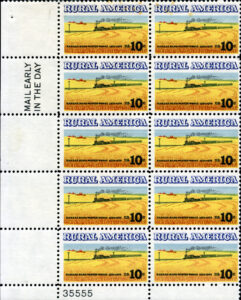
A sheet of stamps that commemorated the “wheat centennial,” 100 years (1874-1974) since “the Mennonites brought wheat to Kansas.”
A U.S. postage stamp was issued also proclaiming a wheat centennial. The U.S. Postmaster General at that time was Elmer Theodore “Ted” Klassen, of Mennonite background, originally from Hillsboro, Kan .[25]

A rendering of Harley Stucky’s proposed Wheat Center
One of the unfinished pieces of Harley Stucky’s centennial projects was a “Wheat Center” to be built along Main Street in North Newton. (If Kauffman Museum or the Mennonite Library and Archives ever have the money to build a new building, I think we should follow this design.)
The Mennonite-wheat connection continues to be made in the present, in contemporary 150th-anniversary programs (although I don’t remember if the museum has it). It gets maybe more attention outside of Mennonite circles, such as in Kansas Wheat Commission podcasts and PBS programs.[26] David Moon labels this wheat story as “a successful exercise in branding.”[27]
The real story can be summarized this way (I couldn’t think of a good way to use the word “kernel” again here):
Winter wheat was widely grown in Kansas and in states to the east before 1874. Some varieties even had names similar to Turkey Red. For example, the newspaper Vermont Chronicle, published in Bellows Falls, Vt., reported in the Feb. 19, 1850, edition, about farmers there planting a “recently imported” “Red Turkey Wheat.” There are numerous other cases like this scattered around the country before 1870. Since we don’t have DNA data on wheat varieties that were being planted before 1874 nor on wheat that Mennonite immigrants planted in the early years, and don’t even have the kind of data that resulted from systematic study of wheat varieties in the 20th century before the widespread use of genetics, we have very limited understanding of what varieties were really in use. I don’t think that any Mennonite immigrants brought seed wheat with them except maybe a few of the Gnadenau families. I don’t think the Anna Barkman story is true, but the Andreas Flaming story seems more plausible. To the extent that Mennonites were responsible for introducing Turkey Red wheat, it was really a Mennonite – Bernhard Warkentin – along with the agricultural scientist Mark Carleton and many anonymous farmers of the mid-1880s and later who received the seed wheat Warkentin and Carleton imported from Ukraine.
There are lots of side tracks that would be really interesting to follow here, but there just isn’t time: threshing stones, tumbleweeds, bindweed
The other two tropes or themes or myths that I want to talk about are more abstract than wheat, less vivid and less easy to notice. The first one is about context. In casual tellings of the 1870s immigration story, there are very few protagonists. There are the Mennonites, and the railroad companies, and maybe the Russian and U.S. governments. Maybe the most obvious left out group is Native Americans, although in most of the recent 150th-anniversary commemorations, the displacement of Native Americans from the land taken up by immigrants has been explicitly included.
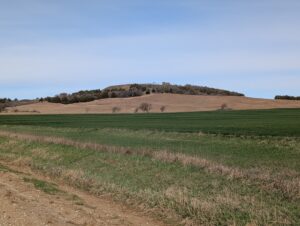
Coronado Heights overlooking the Smoky River Valley and Lindsborg, Kan.
Kansas had been a venue for European-Native interactions for over 300 years by the time the Russian Mennonite immigrants arrived in 1874. Spanish explorers had entered the territory that is now Kansas during the 16th century, during Menno Simons’ lifetime. Coronado in 1541 provided the name for this landscape feature, Coronado Heights, near Lindsborg, Kan. He was followed by a few other Spanish expeditions.
French and Spanish traders and their Native trading partners crossed this area of Kansas during the 17th and 18th centuries. The Santa Fe trail, a commercial trading route, crossed this area starting in the early 19th century. The Native residents in the immediate area here were mostly the group we now call the Wichitas, gradually displaced by the Osage, moving from the southeast. In the 19th century, many Native groups were pushed into Kansas from farther east and there was a complex several-decade period of trade, intermarriage, forced displacement, and creating and dissolving of reservations. The area settled by 1870s immigrants was just to the north of the short-lived Osage Reservation of the mid-19th century and was in territory that was outside the reservation system in Kansas as of 1846 – about 25 years before the immigration.[28]
Another forgotten piece of context is that the Civil War had ended less than a decade before the immigrants’ arrival. Many would argue that the Civil War began in Kansas just 15-20 years before that arrival. You remember “Bleeding Kansas” and “John Brown’s Body Lies A-mouldering in the Grave?” That would be as if it were 2005 or so in relation to us in 2024 – not very long ago.
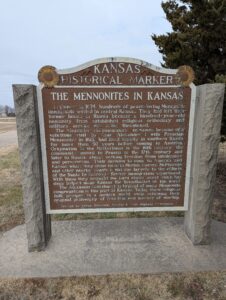
This historical marker near the Alexanderwohl Mennonite Church, Goessel, Kan., claims that the first Mennonites arrived in Kansas in 1874.
This sign at Alexanderwohl Mennonite Church in Goessel, Kan., is maybe one of the more misleading texts in public view about the immigration. It says “The Mennonites of Kansas” (emphasis added) but mentions only the 1874 immigrants from the Russian Empire. The first known Mennonite in Kansas was Abraham H. Martin, who is listed as a subscriber in the Herald of Truth in March 1866.[29] His location was given as “Meniola,” which was a short-lived post office in Franklin County, right in the area of Bleeding Kansas.[30] Martin was born at Clarence Center, N.Y., May 28, 1832, and died at Overbrook, Kan. (Osage County), January 2, 1902.[31] There were quite a few other scattered Mennonite settlers from eastern states in the late 1860s and early 1870s before the Russian immigration. The Spring Valley church in McPherson County was the earliest congregation that survived for an extended time, starting in 1871. The story of the Brunk family from Virginia settling in Marion County and the 14-mile or 23-mile furrow (however long it was) was the core part of the folklore of these early groups.[32] The first Holdeman or Church of God in Christ-Mennonite congregation, the Meridian Church, started in 1873 northeast of Hesston, Kan.[33] A major center of the 1874 migration itself, Halstead, Kan. – where Bernhard Warkentin settled, for example – was formed mainly by Mennonites who had already been in the United States for several decades and moved from farther east, from Summerfield, Ill., mostly.
It’s also widely forgotten that Mennonites weren’t the only German speakers migrating from Russia in the 1870s. The German-Russian Catholics and Lutherans who settled to the northwest of the Mennonites didn’t get any state legislative proclamation for their centennial nor any postage stamp. Military conscription was also a major motivation for this group, even though nonresistance isn’t part of their theologies. I don’t know all that much about their immigration story, but one thing that is surprising is that their memory of their Russian experience (which tended to be longer than that of the Mennonites, running in some cases from the 1760s) is much more negative than the kinds of recollections that Mennonites have.[34]
There is probably more we could say on this theme of context, particularly about the governmental infrastructure, but I want to move on.
My third theme is the most abstract and hardest to express in a single word. The Alexanderwohl historical marker is also an example for this theme. It says “The Mennonites,” but there’s no such thing as the Mennonites. “The Mennonites” implies the idea of Mennonite unity or solidarity or homogeneity, the idea that the Mennonite immigrants were a unitary or unified actor. But the opposite is the case. The immigration process was very contentious and the immigrants themselves were quite varied in backgrounds.
Since we know that the substantial majority of Mennonites remained in Russia, the immigration itself is an example of disunity. The twelve delegates are an example of how most of the Russian Mennonite community was not represented. The delegates broke down into the Bergthal group (an offshoot of Chortitza, all of whom went to Canada), the Hutterites and Kleine Gemeinde, Volhynia (both Swiss and Low German), Berdjansk (a small urban congregation), Alexanderwohl, and Obernessau (a small, outlying Prussian congregation). Except for Alexanderwohl, these were all outside the main core of the Russian Mennonite community socially, culturally, and economically. The same was true of Obernessau in the Vistula Valley. The numerous other Molotschna and Chortitza congregations, and the Vistula Delta congregations, were not represented. Once the delegates began their work, they did not travel together or even meet together as a whole group except for maybe a couple of brief occasions. They did not all visit the same locations and largely worked independently.[35]
David Haury, in his history of the Western District Conference, classified the founders of the conference into eight sub-groups, primarily based on geographic origins, six of them coming to Kansas from Russia or Prussia. His groups would have been broadly defined enough to include the Mennonite Brethren, but this does not count any of the Mennonites such as Abraham Martin who were already in Kansas.[36]
We also know that among the minority who decided to emigrate, some chose to go east rather than west. The Claas Epp story is well known, although not all those who went east were Claas Epp followers. Even at the broadest geographic scale of destination, the emigrants were not unified.
The migration was extremely contentious as soon as it began. We seem to have relatively little documentation about Mennonite internal discussions in Russia, but one interesting source, from persons mostly favorable to emigration, is the extensive correspondence between Bernhard Warkentin and David Goerz. Immediately after Warkentin left on his trip to the United States, Goerz reported to him about public, anonymous, insider criticism of his trip and of the idea of emigration.[37] Goerz continued to comment on numerous criticisms and factional clashes in Mennonite circles until he himself migrated. Fabricated stories of migrants facing disasters circulated back in Russia, made up by Mennonite opponents of migration.[38] In early 1875, a minister at Köppenthal in the Am Trakt/Samara region, Johann Epp, wrote to John F. Funk, editor of the Herald of Truth in the United States, sharply criticizing the emigration movement and Funk’s support for it.[39] Ironically, Epp came to Newton in 1893; he was the grandfather of Theodore H. Epp of the old Back to the Bible radio broadcast.
The immigration ship lists can also provide some insight into Mennonite solidarity or lack of it. The handful of ships that brought large groups, hundreds of people, are the ones most often remembered. But thousands of people came as individuals or small groups of families.[40] These are probably less documented, since individuals or small groups are much harder to find in the ship lists. Even the larger groups were apparently not all that united. Some of the Teutonia ship group, most of whom became the Hoffnungsau congregation, settled in Nebraska. There is an estimate that as much as a third of the group settled elsewhere. And the Teutonia and Cimbria passengers, all supposedly from Alexanderwohl in Russia, did not settle with each other and did not coordinate their new church organizations. The large groups themselves contained forgotten heterogeneity. A plaque near the Alexanderwohl historical marker lists the family heads of those who migrated and founded the congregation, but many of those were not long-term members of Alexanderwohl in Russia. My Thiesen and Goertzen ancestors, for example, were baptized elsewhere than at Alexanderwohl. The ship lists would offer a good opportunity for additional study – where migrants came from and didn’t come from, how different groups came together and split up again, how many came as individual families and who came in larger groups.
Daut wia soo lang tridj, daut es meist nijch meea soo.
Some might label what I’m doing here de-mythologizing, and I thought of using that word myself, but maybe a better word would be de-romanticizing.
– It’s not that the Mennonites (or Anna Barkmann) brought wheat, but a Mennonite, Bernhard Warkentin, brought wheat (along with an American agricultural scientist).
– It’s not that Mennonites came to an empty slate but to a place that was already very busy, including even with other Mennonites who were here before the Russian immigrants.
– It’s not that Mennonites acted together but that the process was very contentious and divisive with people making all sorts of clashing decisions that ended up with migrants scattered across a thousand miles of the North American plains.
Notes
[1] “That was so long ago, it is almost no longer so” (Low German), Rudy Wiebe, Of This Earth: A Mennonite Boyhood in the Boreal Forest (N.p.: Alfred A. Knopf Canada, 2006), ix.
[2](Cambridge: Cambridge University Press, 2020).
[3]Moon, 149-152.
[4]First Biennial Report of the State Board of Agriculture to the Legislature of the State of Kansas for the Years 1877-78 (Topeka, Kan.: Kansas State Board of Agriculture, 1878), 491, The state report gives 857,125 acres for 1877 and 1,297,555 for 1878. David G. Rempel, “C.B. Schmidt, Historian: Facts and Fiction,” Mennonite Life 29: 1 & 2 (Mid-Year 1974): 33-37, is sharply critical of Schmidt’s various Mennonite accounts.
[5]C. Henry Smith, The Coming of the Russian Mennonites: An Episode in the Settling of the Last Frontier 1874-1884 (Berne, Ind.: Mennonite Book Concern, 1927), 84.
[6]MS.68, folder 20, also online. The original of the letter is from the U.S. National Archives, Department of Agriculture – Bureau of Plant Industry, Soils and Agricultural Engineering Records re Introduction of Turkey Red Wheat.
[7]Mark Alfred Carleton, “Hard Wheats Winning Their Way,” Yearbook of the United States Department of Agriculture 1914 (Washington, D.C.: USDA, 1915), 399.
[8]Smith, 206.
[9]C.C. Wedel, “Die Bestrebungen und Errungenschaften auf dem wirtschaftlichen und kommerziellen Gebiet,” 28-36, in Zur neuen Heimat: Die Auswanderung der Mennoniten aus Rußland nach Amerika, nach Vorträgen gehalten auf den Festen zum 50jährigen Jubiläum der Auswanderung, in Hillsboro, Kansas, am. 19. Oktober und in Buhler, Kansas, am 26. Oktober 1924 (Hillsboro, Kan.: Mennonite Brethren Publishing House, 1924), 30
[10]Bliss Isely, Early Days in Kansas (Wichita: Eagle Printing and Lithograph, 1927 [1967 printing]).
[11]Isely, 151-155.
[12]GM #7084.
[13]Bliss Isely, “Why Kansas is a Great Wheat State,” Town Crier, Sunday magazine section of the Wichita Beacon, May 15, 1927, pp. 5, 13.
[14]The Bethel Collegian, May 25, 1927 (vol. 1, no. 32). A copy is in MS.68, box 2, folder 22.
[15]GM number 2689
[16]David V. Wiebe, Grace Meadow: The Story of Gnadenau and Its First Elder, Marion County, Kansas (Hillsboro, Kan.: Mennonite Brethren Publishing House, 1967), facing p. 33.
[17]Wiebe, 43.
[18]“Band of Mennonites Brought Hard Wheat,” Topeka Daily Capital, April 5, 1931, p. 7B.
[19]Kansas: A Guide to the Sunflower State (New York: Viking, 1939), 57.
[20]Keith Sprunger, “The Most Monumental Mennonites,” Mennonite Life 34:3 (Sept. 1979): 10-16.
[21]Cornelius Krahn, ed., From the Steppes to the Prairies (1874-1949) (Newton, Kan.: Mennonite Publication Office, 1949), 11.
[22] Krahn, 100.
[23]Editorial note at the end of David G. Rempel, “C.B. Schmidt,” 37.
[24]“Wheat Centennial Proclaimed,” Mennonite Life 28:2 (June 1973): 46.
[25]https://en.wikipedia.org/wiki/E._T._Klassen (accessed July 16, 2024)
[26]https://kswheat.com/kansas-author-explores-link-between-mennonites-wheat-and-threshing-stones (accessed July 16, 2024) and https://kswheat.com/turkey-red (accessed July 16, 2024)
[27]Moon, 184.
[28]Homer E. Socolofsky and Huber Self, Historical Atlas of Kansas, 2nd ed. (Norman, Okla.: University of Oklahoma Press, 1988), map 13.
[29]Herald of Truth,“Extra Edition to No. 27,” vol. 3, no. 3, whole no. 27, March 1866, p. 27.
[30]Robert W. Baughman, Kansas Post Offices, May 29, 1828-August 3, 1961 (Topeka, Kan.: Kansas State Historical Society, Kansas Postal History Society, 1961), 85
[31]Samuel S. Wenger, ed., The Wenger Book: A Foundation Book of American Wengers (Lancaster, Pa.: Pennsylvania German Heritage History, 1978), 280. Obituary in Herald of Truth, Feb. 15, 1902, vol. 39, no. 4, p. 61.
[32]For more on these groups see Paul Erb, South Central Frontiers: A History of the South Central Mennonite Conference (Scottdale, Pa.: Herald Press, 1974).
[33]Histories of the Congregations, 3rd ed. (Moundridge, Kan.: Gospel Publishers, 1999), 305.
[34]Norbert R. Dreiling, Official Centennial History of the Volga-German Settlements in Ellis and Rush Counties in Kansas 1876-1976. Hays, Kan.: Volga-German Centennial Association, 1976.
[35]Hans Werner, “‘Something . . . we had not seen nor heard of’: The 1873 Mennonite Delegation to Find Land in ‘America’”, Preservings 34 (2014), 11-20. Pages 17-20 have a detailed chronology showing how little the whole group interacted.
[36]David A. Haury, Prairie People: A History of the Western District Conference (Newton, Kan.: Faith and Life Press, 1981), 25-57.
[37]Goerz to Warkentin, May 24/June 5, 1872. The letters and translations are in both the Warkentin and Goerz papers in the MLA.
[38]Smith, 122-124. For other reports of criticism and contention, see John B. Toews, “Nonresistance Reexamined: Why did Mennonites Leave Russia in 1874?” Mennonite Life 29: 1 & 2 (Mid-Year 1974): 8-13.
[39]Leonard Gross and Ivan Friesen, “Zur Einwanderung rußlandischer Mennoniten nach Nordamerika vor 100 Jahren,” Mennonitische Geschichtsblätter, 1974, Jg. 31, pp. 107-113.
[40]Probably obeys Zipf’s law.
